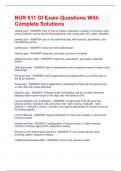NUR 611 GI Exam Questions With
Complete Solutions
visceral pain - ANSWER- pain in internal organs, distension or spasm of a hollow organ,
poorly localized, covers several body segments, dull crampy pain, N/V, pallor, sweating
somatic pain - ANSWER- pain in the abdominal wall, well localized, asymmetric, and
intensified by jarring
parietal pain - ANSWER- sharp and well localized pain
referred pain - ANSWER- achy pain, felt away from area of disease
abdominal exam order - ANSWER- inspection, auscultation, percussion, palpation
(IAPP)
Obturator's sign - ANSWER- test for appendicitis; pain on passive internal rotation of the
flexed thigh
Rovsing's sign - ANSWER- test for appendicitis by palpating the LLQ, eliciting pain in
the RLQ if positive
Psoas sign - ANSWER- test for appendicitis; extending the thigh with the patient lying
on their side with knees extended
Murphy's sign - ANSWER- indicates acute cholecystitis; ask pt to exhale, examiner
palpates below costal margin on the right side mid-clavicular line
recommendations for constipation - ANSWER- increase fiber to 25-35 g per day;
physical activity, hydration until urine clear; mild - bulk forming, moderate - stool
softener +/- stimulant, chronic - osmotic; (only agents appropriate for long term use are
the bulking agents)
chronic diarrhea - ANSWER- diarrhea that lasts for more than 2 weeks or recurs over
months to years
osmotic diarrhea - ANSWER- malabsorption r/t injury to colon, or celiac disease,
common in women ages 40-50, responds to fasting
Secretory (non inflammatory) diarrhea - ANSWER- E coli, laxative abuse, large
amounts, doesn't respond to fasting
irritable bowel disease (IBD) - ANSWER- crohn's and ulcerative colitis
, altered intestinal motility - ANSWER- diabetic neuropathy, dumping syndrome, or IBS
functional dyspepsia - ANSWER- presence of chronic intermittent symptoms without
mucosal lesions or other structural GI abnormalities for at least 3 months (epigastric
pain, postprandial fullness, early satiety, epigastric burning)
first line dyspepsia treatment - ANSWER- H2 antagonists (ranitidine), OTC omeprazole,
H. pylori eradication
second line dyspepsia treatment - ANSWER- gastric motility drugs (metoclopramide,
erythromycin), amitriptyline at hs, SSRIs, antacids, sucralfate, misoprostol
tenesmus - ANSWER- The feeling that you need to pass stools, even though your
bowels are already empty. It may involve straining, pain, and cramping.
C diff treatment - ANSWER- flagyl, vancomycin, or bacitracin suspension
S. aureus infection s/s - ANSWER- onset: 30 min - 6 hours
s/s: N/V, cramping, soft stools
**creamy food is common source (egg salad, cream filled pastries, undercooked
poultry)
salmonella infection s/s - ANSWER- onset: 6-72 hours
s/s: N/V, cramps, bloody stool, WBCs in stool
**undercooked poultry, red meats, contaminated pets, turtles, reportable
shingella infection s/s - ANSWER- onset: 2-4 days
s/s: abd pain, fever, watery diarrhea, WBCs in stool
**fecal-oral route, homosexual transmission, reportable
E. coli infection s/s - ANSWER- onset: 10 hrs - 6 days
s/s: cramps, no fever, watery diarrhea
**Traveler's diarrhea, contaminated food/water
Campylobacter infection s/s - ANSWER- onset: 1-7 days
s/s: N/V, fever, abd pain, watery & bloody diarrhea, WBCs in stool
**undercooked poultry, unpasteurized milk, contaminated water
Giardia infection s/s - ANSWER- onset: 1-4 weeks
s/s: foul smelling stools, abd pain, flatulence
**fecal-oral spread, contaminated water common
C. difficile infection s/s - ANSWER- onset: common after abx use (fluoroquinolones,
clindamycin)
s/s: fever, leukocytosis, bloody watery diarrhea, cramps, WBCs in stool
**DC abx if poss, rehydrate aggressively, cx most sensitive for diagnosis




